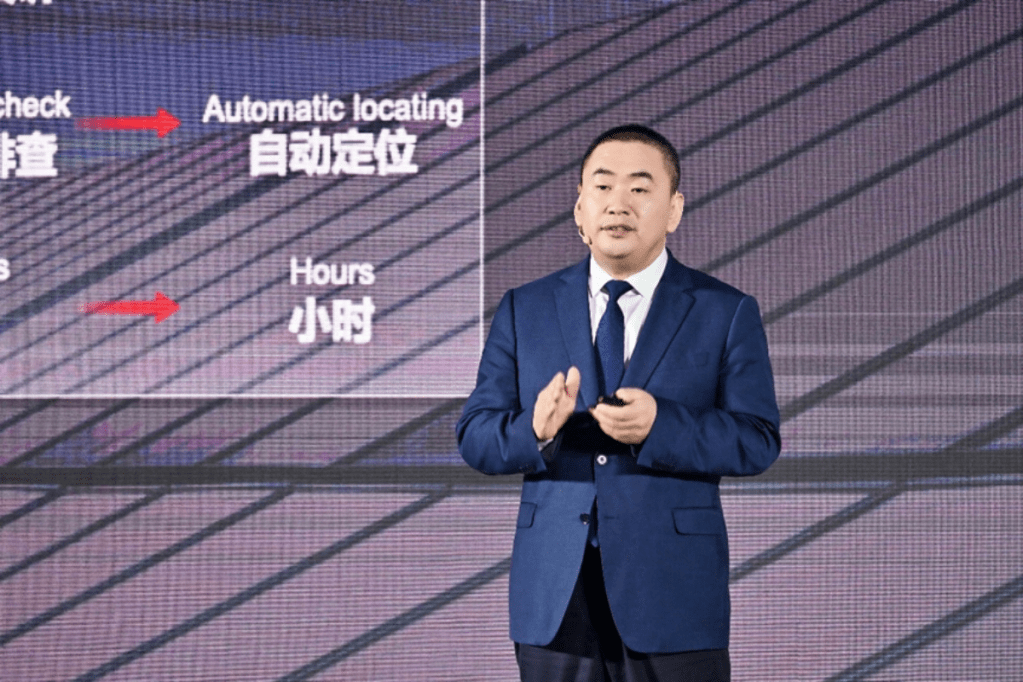China is leading the world in the new energy sector. The rapid development of new energy has posed major challenges to power grids, which can only be solved through new forms of productivity. The unpredictable nature of renewable energy and fast electrification of loads posed a range of challenges to the power system, including difficult power control, high line loss, low energy absorption and consumption, and difficult operations. Solving these challenges will require a new approach that centers on integrating digital and electric power technologies.
David Sun, Vice President of Huawei and CEO of Electric Power Digitalization at Huawei, highlighted the importance of finding technologies for scenarios and scenarios for technologies.
“We believe there are five key components to systematically embracing digital and intelligent transformation: the communication base, massive data, AI breakthroughs, digital rules, and cyber security. On top of this, we also need to resolve the contradiction of production relationships brought about by the extensive development of digital intelligence in the power industry,” said Sun. “To support the implementation of enterprises’ phased key tasks and long-term strategies, we need to develop scenario-based services and build digital and intelligent scenarios. We should approach the digital and intelligent transformation of key scenarios from business, economic, and technical perspectives.”
From the business perspective: understanding local challenges and priorities
The business perspective, built upon business KPIs and drivers, is the most important factor when integrating digitalization and business systems. Take the power distribution and consumption scenario of the power system. Key services include line loss reduction, power supply reliability improvement, new energy load management, O&M efficiency improvement, internal and external satisfaction improvement, and agile innovation support.
In different countries and regions, power companies have different key challenges and service priorities. For example, line loss reduction is Africa’s biggest challenge while in Saudi Arabia, power companies are more concerned about power supply reliability.
In China, the biggest concern is about the massive access to new energy and loads. In the case of distributed PV access, solar power is difficult to absorb and consume at noon, which may cause reverse heavy loads or overloads and damage to transformers. To solve this problem, edge computing can help monitor the voltage and reverse active power in minutes, as well as perform smooth adjustments in seconds according to threshold values and rules.
From the economic perspective: keeping in mind ROI and asset appreciation
The economic perspective requires quantitative ROI evaluation for quick decision-making. In an instance, Huawei’s Intelligent Distribution Solution (IDS) was deployed, with an expected lifecycle of 10 years. The total amount of CAPEX and OPEX involved will be $2.5 billion. If the line loss is reduced by 3%, it will generate $6 billion in revenue for the customer. In the 10-year lifecycle, the self-built communication network solution will reduce OPEX by about $700 million and the lifecycle of optical fibers can exceed 30 years.
Huawei’s IDS provides digital and intelligent enablement to help power companies increase the value of human resources and assets. For example, it can help customers support two-fold business growth with the same number of staff. In addition, the solution helps power companies improve customer satisfaction, embrace green development, and improve brand and social image.
From the technical perspective: digitalization the key step towards integration
From the technical perspective, Sun opined the need for a future-oriented, open, and sustainable technical architecture to ensure companies move in the right direction in long-term digital development.
“To be specific, the communication target network needs to solve two major problems regarding 400V communication and medium-voltage backhaul in distribution network communication. The network must be secure, reliable, flexible and affordable. The vertical block architecture in the information age is evolving into a cloud-edge-device architecture featuring horizontal layering and decoupling in the digital era,” explained Sun.
There has also been a change from single-point digitalization to architecture-supported, open, evolvable, and systematic digitalization. The enterprise OS is the “root capability” of enterprise digital transformation. As such, it’s key to support heterogeneous deployment across the cloud, edge, and device, and shield differences and enable the flexible access of massive devices.
This way, complex services can run agilely at each layer and interact with each other across layers. The software and hardware of edge devices are decoupled, similar to how the feature phone evolved into the smartphone. This implements software-defined, supports the OTA upgrade of protocols, operating systems, and apps, and enables flexible autonomy under centralized governance.
In the digital era, from information-based integration to agile innovation, the innovation platform must support interconnection between clouds, between edges and devices, and massive cloud-edge-device synergy to ensure the quick response to enterprise needs.
In summary, from the business perspective, power companies should focus on scenarios, solve problems and create value. From the economic perspective, power companies should pay attention to return on investments as well as the appreciation of human resources and data assets. From the technical perspective, power companies should move in the right direction in our journey of digitalization. Sun believes these three perspectives can support quick decision-making, drive the implementation of phased business strategies, and promote the sustainable development of power companies.

